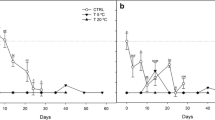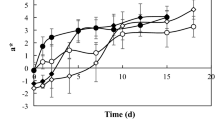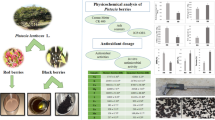Abstract
Nisin and citric acid are generally recognized as safe (GRAS) for using as a food ingredient and often used to control the microbial contamination of fresh-cut fruits and vegetables. However, their effects on phenolics and antioxidants remain unclear. Here we used 50 μg·mL-1 nisin combination with 1% (w/v) citric acid (N+C) to wash fresh-cut onions and the phenolic compounds, antioxidant capacity, microbial load, slice color were evaluated during the storage period. N+C treatment decreased the total polyphenols (TP) and quercetin contents (p < 0.05), as compared to the control at day 0, but did not affect phenolic acids and antioxidant capacity (ABTS, DPPH, and FRAP assays). During storage, antioxidant capacity, TP, and flavonoid contents increased. Storage had mixed effects on the phenolic acids (caffeic acid, vanillic acid, and ferulic acid increased, chlorogenic acid remained fairly stable). N+C treatment reduced the microbial counts and total viable counts (TVC) of fresh-cut onions below the detection limit until 5 days of storage. After 15 days storage, TVC of N+C treated samples remained significantly (p < 0.05) lower than controls. In addition, N+C treatment led to better color retention during storage. Therefore, N+C might be used as a safe preservative for fresh-cut onions.
Similar content being viewed by others
Literature Cited
Barbosa AAT, De Araújo HGS, Matos PNM, Carnelossi AG, De Castro AA (2013) Effects of nisin-incorporated films on the microbiological and physicochemical quality of minimally processed mangoes. Int J Food Microbiol 164:135–140
Benzie IFF, Strain JJ (1996) The ferric reducing ability of plasma (FRAP) as a measure of “antioxidant power”: The FRAP assay. Anal Biochem 239:70–76
Cheng A, Chen X, Jin Q, Wang W, Shi J, Liu Y (2013) Comparison of phenolic content and antioxidant capacity of red and yellow onions. Czech J Food Sci 31:501–508
Davidson PM, Zivanovic S (2003) The use of natural antimicrobials. In Zeuthen P, Bogh-Sorensen L, eds, Food preservation techniques. Boca Raton, Fla.: CRC Press LLC, USA. pp 5–30
Deng GF, Lin X, Xu XR, Gao L, Xie JF, Li HB (2013) Antioxidant capacities and total phenolic contents of 56 vegetables. J Funct Foods 5:260–266
Dixon RA, Paiva NL (1995) Stress-induced phenylpropanoid metabolism. Plant Cell 7:1085–1097
Fukumoto LR, Toivonen Peter MA, Delaquis Pascal J (2002) Effect of wash water temperature and chlorination on phenolic metabolism and browning of stored iceberg lettuce photosyntetic and vascular tissues. J Agric Food Chem 50:4503–4511
Gil MI, Selma MV, López-Gálvez F, Allende A (2009) Fresh-cut product sanitation and wash water disinfection: Problems and solutions. Int J Food Microbiol 134:37–45
Gökçe FA, Cemal K, Serçe S, Özgen M (2010) Effect of scale color on the antioxidant capacity of onions. Sci Hortic 123:431–435
Hagen S, Solhaug KA, Bengtsson GB, Borge GIA, Bilger W (2006) Chlorophyll fluorescence as a tool for non-destructive estimation of anthocyanins and total flavonoids in apples. Postharvest Biol Technol 41:156–163
Heredia B, Cisneros-Zevallos L (2009) The effect of exogenous ethylene and methyl jasmonate on pal activity, phenolic profiles and antioxidant capacity of carrots (Daucus carota) under different wounding intensities. Postharvest Biol Technol 51(2):242–249
Hu W, Jiang A, Tian M, Liu C, Wang Y (2010) Effect of ethanol treatment on physiological and quality attributes of fresh-cut eggplant. J Sci Food Agric 90:1323–1326
Jiang Y, Pen L, Li J (2004) Use of citric acid for shelf life and quality maintenance of fresh-cut Chinese water chestnut. J Food Eng 63:325–328
Kang HM, Saltveit ME (2002) Antioxidant capacity of lettuce leaf tissue increases after wounding. J Agric Food Chem 50:7536–7541
Kiassos E, Mylonaki S, Makris DP, Kefalas P (2009) Implementation of response surface methodology to optimise extraction of onion (Allium cepa) solid waste phenolics. Innov Food Sci Emerg Technol 10:246–252
Kaur C, Joshi S, Kapoor HC (2009). Antioxidants in onion (Allium cepa L) cultivars grown in India. J Food Biochem 33:184–200
Little CL, Taylor FC, Sagoo SK, Gillespie IA, Grant K, McLauchlin J (2007) Prevalence and level of Listeria monocytogenes and other Listeria species in retail pre-packaged mixed vegetables salads in the UK. Food Microbiol 24:711–717
Liu F, Li Y (2006) Storage characteristics and relationships between microbial growth parameters and shelf life of MAP sliced onions. Postharvest Biol Technol 40:262–268
Liu W, Zou L, Liu J, Zhang Z, Liu C, Liang R (2013) The effect of citric acid on the activity, thermodynamics and conformation of mushroom polyphenoloxidase. Food Chem 140:289–295
Lu X, Wang J, Al-Qadiri HM, Ross CF, Powers JR, Tang J, Rasco BA (2011) Determination of total phenolic content and antioxidant capacity of onion (Allium cepa) and shallot (Allium oschaninii) using infrared spectroscopy. Food Chem 129:637–644
Naim F, Zareifard MR, Zhu S, Huizing RH, Grabowski S, Marcotte M (2008) Combined effects of heat, nisin and acidification on the inactivation of Clostridium sporogenes spores in carrot-alginate particles: From kinetics to process validation. Food Microbiol 25:936–941
Ozgen M, Reese RN, Tulio JAZ, Scheerens JC, Miller AR (2006) Modified 2, 2-azino-bis-3-ethylbenzothiazoline-6-sulfonic acid (ABTS) method to measure antioxidant capacity of selected small fruits and comparison to ferric reducing antioxidant power (FRAP) and 2, 2-diphenyl-1-picrylhydrazyl (DPPH) methods. J Agric Food Chem 54:1151–1157
Parish ME, Beuchat LR, Suslow T V, Harris LJ, Garret EH, Farbe JN (2003) Methods to reduce/eliminate pathogens from fresh and fresh-cut produce. Compr Rev Food Sci Food Safety 2:161–173
Park SH, Choi MR, Park JW, Park KH, Chung MS, Ryu S, Kang DH (2011) Use of organic acids to inactivate Escherichia coli O157:H7, Salmonella Typhimurium, and Listeria monocytogenes on organic fresh apples and lettuce. J Food Sci 76:M293–M298
Pérez-Gregorio MR, González-Barreiro C, Rial-Otero R, Simal-Gándara J (2011a) Comparison of sanitizing technologies on the quality appearance and antioxidant levels in onion slices. Food Control 22:2052–2058
Pérez-Gregorio MR, García-Falcón MS, Simal-Gándara J (2011b) Flavonoids changes in fresh-cut onions during storage in different packaging systems. Food Chem 124:652–658
Prakash D, Singh BN, Upadhyay G (2007) Antioxidant and free radical scavenging activities of phenols from onion (Allium cepa). Food Chem 102:1389–1393
Pushkala R, Parvathy KR, Srividya N (2012) Chitosan powder coating, a novel simple technique for enhancement of shelf life quality of carrot shreds stored in macro perforated LDPE packs. Innov Food Sci Emerg Technol 16:11–20
Rahman SME, Jin YG, Oh DH (2011) Combination treatment of alkaline electrolyzed water and citric acid with mild heat to ensure microbial safety, shelf-life and sensory quality of shredded carrots. Food Microbiol 28:484–491
Reyes LF, Villarreal JE, Cisneros-Zevallos L (2007) The increase in antioxidant capacity after wounding depends on the type of fruit or vegetable tissue. Food Chem 101:1254–1262
Roldán-Marín E, Sánchez-Moreno C, Lloría R, de Ancos B, Cano MP (2009) Onion high-pressure processing: Flavonol content and antioxidant activity. LWT-Food Sci Technol 42:835–841
Santas J, Carbó R, Gordon MH, Almajano MP (2008) Comparison of the antioxidant activity of two Spanish onion varieties. Food Chem 107:1210–1216
Sellappan S, Akoh CC (2002) Flavonoids and antioxidant capacity of Georgia-grown vidalia onions. J Agric Food Chem 50:5338–5342
Shahidi F, Liyana-Pathirana CM, Wall DS (2006) Antioxidant activity of white and black sesame seeds and their hull fractions. Food Chem 99:478–483
Sharma K, Ko EY, Assefa AD, Ha S, Nile SH, Lee ET, Park SW (2015) Temperature-dependent studies on the total phenolics, flavonoids, antioxidant activities, and sugar content in six onion varieties. J Food Drug Anal 23:243–252
Siddiq M, Roidoung S, Sogi DS, Dolan KD (2013a) Total phenolics, antioxidant properties and quality of fresh-cut onions (Allium cepa L.) treated with mild-heat. Food Chem 136:803–806
Siddiq M, Sogi DS, Dolan KD (2013b) Antioxidant properties, total phenolics, and quality of fresh-cut ‘Tommy Atkins’mangoes as affected by different pre-treatments. LWT-Food Sci Technol 53:156–162
Silverira AC, Conesa A, Aguayo E, Artes F (2008) Alternative sanitizers to chlorine for use on fresh-cut “Galia” (Cucumis melo var. catalupensis) melon. J Food Sci 73:M405–M411
Supapvanich S, Pimsaga J, Srisujan P (2011) Physicochemical changes in fresh-cut wax apple (Syzygium samarangenese [Blume] Merrill & L.M. Perry) during storage. Food Chem 127:912–917
Suresh S, Guizani N, Al-Ruzeiki M, Al-Hadhrami A, Al-Dohani H, Al-Kindi I, Rahman MS (2013) Thermal characteristics, chemical composition and polyphenol contents of date-pits powder. J Food Eng 119:668–679
Tudela JA, Cantos E, Espín JC, Tomás-Barberán FA, Gil MI (2002) Induction of antioxidant flavonol biosynthesis in fresh-cut, potatoes. Effect of domestic cooking. J Agric Food Chem 50(21):5925–5931
Xu W, Qu W, Huang K, Guo F, Yang J, Zhao H, Luo YB (2007) Antibacterial effect of Grapefruit Seed Extract on food-borne pathogens and its application in the preservation of minimally processed vegetables. Postharvest Biol Technol 45:126–133
Author information
Authors and Affiliations
Corresponding author
Rights and permissions
About this article
Cite this article
Chen, C., Hu, W., Zhang, R. et al. Levels of phenolic compounds, antioxidant capacity, and microbial counts of fresh-cut onions after treatment with a combination of nisin and citric acid. Hortic. Environ. Biotechnol. 57, 266–273 (2016). https://doi.org/10.1007/s13580-016-0032-x
Received:
Revised:
Accepted:
Published:
Issue Date:
DOI: https://doi.org/10.1007/s13580-016-0032-x




